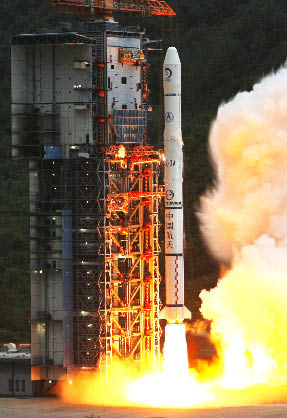| Looking Up
Phase II of China's Lunar Probe Program
By staff reporter ZHOU CHANG
3, 2, 1... Blast off! China’s first moon probe – the Chang’e-1 – on October 24, 2007.
PREPARATIONS are in full swing for Chang’e-2, set to go into orbit 400,000 km above the earth by the end of 2010. This task requires rockets of greater power and precision than those behind China’s first space triumph. On February 13, 2004 China unveiled its three-stage moon exploration program: Phase I (orbiting), launch of a lunar probe to send back data within three years; Phase II (landing), putting an unmanned wheeled rover on the moon within six years; and Phase III (returning), the collection of soil samples from the moon’s surface slated for sometime before 2020. The success of Chang’e-1 (orbiting) will be followed up by the launching of three more Chang’e probes during the second stage of the nation’s lunar exploratory program.
Preparing for a Closer Look
Marking a transition between the Chang’e-1 and Chang’e-3, the Phase II satellite will survey the moon surface and document Chang’e-1’s wreck and impact crater. The data will be used to prepare for the safe landing of Chang’e-3.
The Chang’e-3 is scheduled to lift off in 2013. After landing on the moon, it will dispatch a moon rover to conduct surveys of the lunar surface. A working model of China’s moon rover is currently on display in the Space Pavilion at the ongoing Shanghai World Expo. Hot on the heels of the Chang’e-3, the Chang’e-4 will carry out the mission of charting the moon’s geological structure and resources on a much broader scope, with the intention of bettering all mankind’s understanding of the moon.
Moon Rock-Hounding
The core task for the third stage of China’s lunar probe program is collecting moon rock and dust samples for analysis. China is hoping to harvest its own moon samples by 2020. Argumentation for Phase III is already underway. Key technical challenges have been met, including new pneumatic techniques, efficient lunar surface landings and launchings, and safe transitioning into the earth’s atmosphere on the return, as well as the development of larger capacity lift rockets powered by nontoxic liquid fuels.
China acquired its first moon rock in 1978, when then U.S. national security advisor Zbigniew Kazimierz Brzezinski presented it as a gift from President James Carter. Half of the sample can be seen on display at the Beijing Planetarium, while the other half has been analyzed by over 100 of the nation’s top scientists, yielding a dozen or so papers.
Lunar Real Estate
“It will take a long time and immense technical and scientific preparation to construct a livable space station on the moon”, was how Ouyang Ziyuan described prospects for China’s manned moon mission. We caught up with the chief scientist of China’s moon probe project and Chinese Academy of Sciences academician speaking at the 2010 Global Lunar Conference held in Beijing last June. As he pointed out, the building of a moon base could be considered only after a safe delivery of astronauts to the moon’s surface, and their return, has been accomplished – a scenario that China has not yet marked on its calendar. In fact, the country has yet to commence its manned lunar explorations. “Manned exploration is technically demanding. We have to lay a solid technical and scientific foundation and see how the work proceeds before drawing up a specific schedule,” Mr. Ouyang Ziyuan was quoted as saying.
Yu Dengyun, deputy chief designer of China’s lunar probe project, confirmed that the nation has no plan for a manned moon mission, but relevant authorities and people are actively involved in research and theoretical construction of the project. According to Mr. Yu, after concluding the current lunar exploration program, China will conduct unmanned surveys of the moon, and then establish an unmanned station there. In the future when the conditions are ripe, Chinese astronauts will one day be camped out on the moon.
C | 

